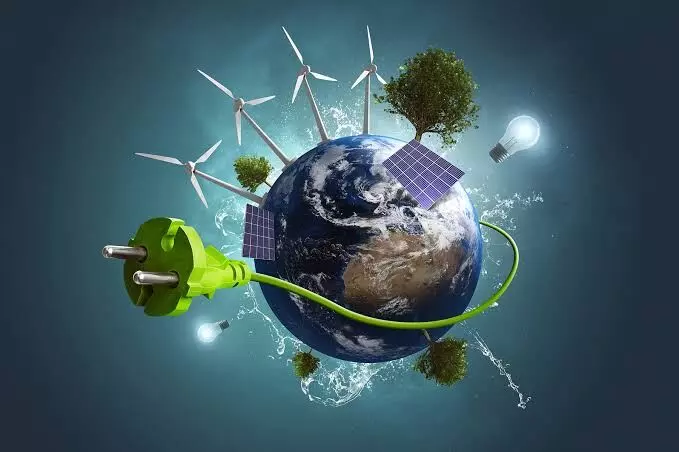India exploring energy transition partnerships with Singapore, Southeast Asia: Official

Singapore: India is exploring opportunities to accelerate the regional energy transition while ensuring energy security across Southeast Asia, starting with Singapore, where several alternative energy projects are already in progress, a senior Indian official said here. Ghanshyam Prasad, Chairman of the Central Electricity Authority -- a statutory body under the Ministry of Power -- asserted that the need of interconnection has been highlighted to use the regional renewable resources in an optimal manner and a huge opportunity awaits if the South Asia and Southeast Asia grids are interconnected. “One of the options is to have a direct interconnection between India and Singapore. This was in line with the ‘One Sun One World One Grid' principles, which originated from India. Through Singapore, the whole of the South East Asian countries will benefit,” Prasad told reporters on the sidelines of an international energy conference in Singapore. Prasad said India could export renewable power -- generated from solar, wind, hydro, and pumped storage projects -- to Singapore and the wider region. “To start with, the link could have a capacity of about 2,000 MW,” he noted. “The export of green energy will help Singapore and maybe be whole of Southeast Asian countries to diversify their power portfolio needs and accelerate energy transition to green energy,” said Prasad, who is attending the week-long Singapore International Energy Week (SIEW) 2025, which opened on October 27.
Highlighting India’s success in harnessing renewable energy, Prasad said the country has already installed more than 30,000 MW of new capacity so far this year and expects to reach 40,000 MW by the end of the year. “India is one of the leaders in green energy transition, and Singapore, as well as other Southeast Asian countries, acknowledged that tapping power from Indian sources would help reduce significantly future gas fuel needs for electricity generation,” said Prasad. Further, India is adding more renewable and hydropower capacity. It has a hydro pump storage capacity of 240 GW and is expected to add around 60 GW by 2034. India is also planning to add 100-GW nuclear capacity by 2047, he pointed out. A full-scale South Asia-Southeast Asia grid connection, Prasad said, could extend solar energy availability by an additional two-and-a-half-hours, reducing the need for energy storage. Thus, leading to reduction in cost of supply for the electricity consumers. Industry observers at the conference said India’s offer of green energy to Southeast Asian markets will be most competitive, given the rupee-based price trading through the electricity grid against higher value regional currencies, especially the Singapore dollar, as the Asian financial hub is seen a natural trade funding centre for green energy, building on its global petroleum trading legacy. In March this year, India and Singapore had signed a Letter of Intent (LoI) for Green and Digital Shipping Corridor (GDSC), with a focus on digitalisation and decarbonisation. The Singapore-India GDSC, when established, will enhance collaboration from both countries and help accelerate the development and uptake of zero or near-zero GHG emission technologies and the adoption of digital solutions, a joint release from Maritime and Port Authority of Singapore and India’s Ministry of Ports, Shipping had then said on March 25, 2025.
Meanwhile, addressing the energy conference on Tuesday, Singapore’s Minister in charge of Energy, Tan See Leng called for stronger collaboration and smarter systems to power South East Asia’s energy transition. Against the backdrop of rising demand and decarbonisation pressures, he urged policymakers and industry leaders to build an ecosystem that is digitally intelligent, regionally integrated, and resilient while advancing sustainability. Opening the Singapore-IEA Forum, Tan underscored the pivotal role of smart grids, powered by advanced technologies such as artificial intelligence (AI), to improve energy demand forecasting, optimise operations, and enhance reliability. Singapore is already deploying AI through innovations like the Grid Digital Twin, which monitors and simulates the national power network in real time -- a model that could be scaled regionally through partnerships with the IEA, said Tan, who is also Minister for Manpower and Trade and Industry. Tan emphasised the “win-win benefits of cross-border electricity trade.” The IEA projects that average electricity costs in Southeast Asia could fall from USD 120/MWh to about USD 80/MWh by 2050 as renewables grow. The minister also pointed out that a Singapore-US Feasibility Study on regional power grids found that greater regional energy integration could spur economic growth by driving investment and creating new jobs in the renewable energy manufacturing sector. The traditionally fossil fuel-reliant Jurong Island of Singapore, a hub for petroleum and petrochemical complexes, is revving its green engines to become more sustainable, with close to 300ha – about 10 per cent of its land, or an area slightly bigger than 400 football fields – set aside for new energies, such as greener fuels, according to presentation at forum during the energy week. The industrial island, off the mainland’s west coast, will also host Singapore’s largest low-carbon data centre park, with an additional 20 ha of land reserved for this. Four years after the energy and chemicals hub launched its 2030 sustainability goals, a number of companies on the island have made some progress in energy efficiency and producing sustainable goods, such as green solvents. These announcements were made by industrial developer JTC Corporation (JTC) and the Economic Development Board (EDB) on October 27, in conjunction with the Energy Week. Tan noted that there has been increasing interest from specialty chemical players to grow their presence in the Republic, driven by growth in regional demand for higher-quality products. He said Jurong Island will be a global test bed for new energies and low-carbon technologies. These refer to the use of fuels such as ammonia or hydrogen, which do not produce carbon dioxide when burned, and technology like carbon capture.



